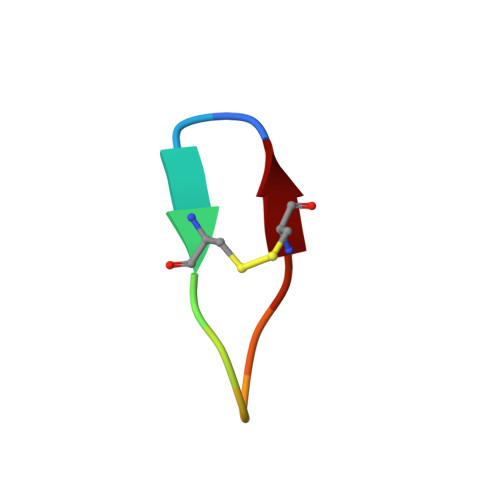Comprehensive computational design of ordered peptide macrocycles.
Hosseinzadeh, P., Bhardwaj, G., Mulligan, V.K., Shortridge, M.D., Craven, T.W., Pardo-Avila, F., Rettie, S.A., Kim, D.E., Silva, D.A., Ibrahim, Y.M., Webb, I.K., Cort, J.R., Adkins, J.N., Varani, G., Baker, D.(2017) Science 358: 1461-1466
- PubMed: 29242347
- DOI: https://doi.org/10.1126/science.aap7577
- Primary Citation of Related Structures:
6BE7, 6BE9, 6BEN, 6BEO, 6BEQ, 6BER, 6BES, 6BET, 6BEU, 6BEW, 6BF3, 6BF5 - PubMed Abstract:
Mixed-chirality peptide macrocycles such as cyclosporine are among the most potent therapeutics identified to date, but there is currently no way to systematically search the structural space spanned by such compounds. Natural proteins do not provide a useful guide: Peptide macrocycles lack regular secondary structures and hydrophobic cores, and can contain local structures not accessible with l-amino acids. Here, we enumerate the stable structures that can be adopted by macrocyclic peptides composed of l- and d-amino acids by near-exhaustive backbone sampling followed by sequence design and energy landscape calculations. We identify more than 200 designs predicted to fold into single stable structures, many times more than the number of currently available unbound peptide macrocycle structures. Nuclear magnetic resonance structures of 9 of 12 designed 7- to 10-residue macrocycles, and three 11- to 14-residue bicyclic designs, are close to the computational models. Our results provide a nearly complete coverage of the rich space of structures possible for short peptide macrocycles and vastly increase the available starting scaffolds for both rational drug design and library selection methods.
Organizational Affiliation:
Department of Biochemistry and Institute for Protein Design, University of Washington, Seattle, WA 98195, USA.














